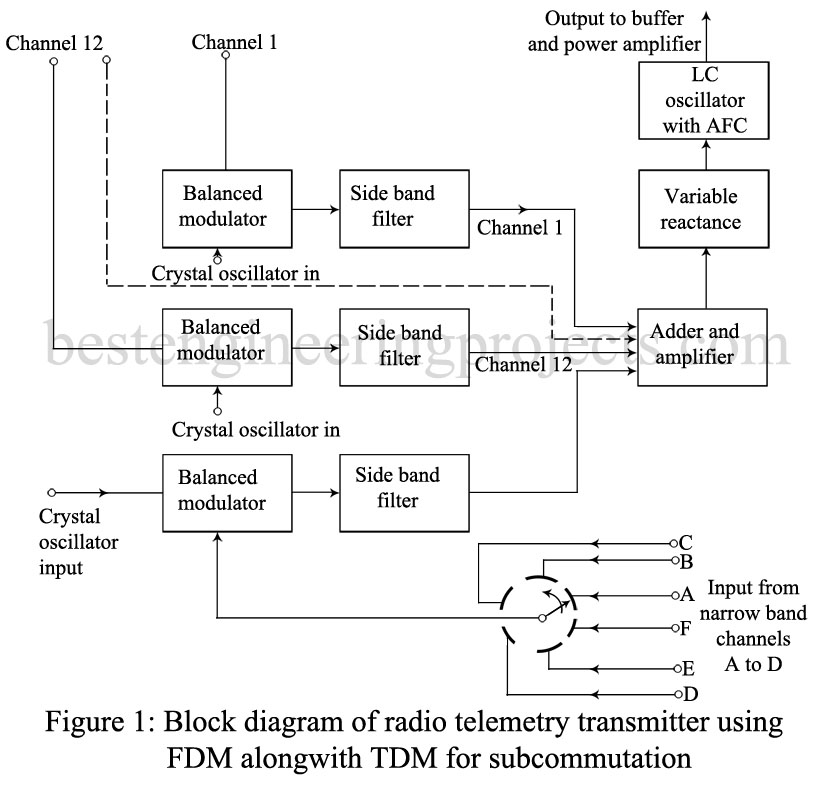Telemetry signifies performing measurements on distant objects. It is, no doubt, possible to use hydraulic or wire circuits for this purpose. But the more prevalent form is the radio telemetry system and is discussed here in brief. Instead of using radio telemetry system, the same purpose may be achieved by posting observers on the distant spot or having some form of multitrack recorders on the site from which data may be collected at convenient time.
However, in several cases, neither of the above two alternatives are feasible and then radio telemetry system has to be used. Thus radio telemetry is extremely useful in obtaining in-flight information from fighter aircraft and from missiles. In these cases, placing observers or even recorders on board is far too risky. In general, it is required to monitor several quantities simultaneously. Hence the demand for multichannel radio telemetry becomes obvious. Sophistication of the system is extended beyond the basic radio telemetry to include remote control of such flights and remote control plus flight testing of guided missiles, satellite launching and control in orbit and finally control of extraterrestrial probes. Several other applications of radio telemetry are in existence such as remote location gathering of meteorological data and control of problem pipeline systems.
Checkout the article on Telemetry Troubleshooting System and Fiber Optic Telemetry System using NE555.
Process of radio telemetry can become quite complex since it involves numerous problems concerning transmitters, antenna location and orientation, noise and interference. Hence the other two forms of data acquisition namely the human observer and multitrack recorder, are always investigated first. However, because of space and weight limitations, there is a limit on the total data that can be stored. Further human observers are quite often unacceptable. Accordingly radio telemetry is popularly used but with discretion.
Methods of Radio Telemetry System
Several channels are needed simultaneously in radio telemetry to accommodate different parameters. It is impracticable to use different radio links for all these channels. All the channels are, therefore, accommodated on only one radio link using either Frequency Division Multiplexing (FDM) or Time Division Multiplexing (TDM) or both.
Thus when telemetry is used with a pilotless aircraft, different telemetered variables change at different speeds. Airspeed and altitude change rather slowly needing narrow band channels whereas wing flutter may change quite rapidly needing relatively wideband channels. The mixture is achieved through a process called subcommutating whose mechanical version is illustrated in Fig 1.
Subcommutating consists in subdividing a wideband channel into several narrow-band channels. In practice, the system uses FDM in general and TDM for subcommutated channels. Mechanical commutation may be used here since the variation is slow. Alternatively we may use FDM for subcommutated channels or TDM for both.
Complex modulation arrangements are used today. Hence some sort of standardization is needed when describing a given system. Thus SSB/FM is a system in which each of the channels modulates its subcarrier and then all the modulated subcarriers grouped together frequency modulate the main carrier. This in fact constitutes the FDM system. PCM/AM signifies time division multiplex of pulse code modulation with the pulse train amplitude modulating the main carrier. Finally PWM/AM/FM stands for a system in which the subcarriers are amplitude modulated by their signals and in turn they frequency modulate the main carrier. Also one of the channels has been subcommutated and each of the subchannels is fed PWM (Pulse width modulated) signal.
Rigid standardization has not been fully implemented in this field with the result that a large number of telemetering systems are in use. Out of these, FM/FM frequency division multiplexing system is the one most widely used and is often extended to PAM/FM/FM when subcommutating is needed. This system has merits of high reliability and flexibility but suffers from the drawback that it requires greater bandwidth and carrier strength than the pure pulse system. Other systems such as PPM/AM, PWM/FM, PAM/FM and even PCM/FM are being used in certain applications, each system having its own merits for specific applications. A pure pulse system such as PCM/AM has the advantage that if subcommutation is required, the subcommutator can be synchronized with the main commutator resulting in simplified circuitry and reduced frequency drift.
FCC and international regulations and agreements have been assigned for radio telemetry frequency bands from 216 to 220 MHz and from 2.2 to 2.3 GHz. To ensure reliable communication, space diversity and frequency diversity are used extensively.

Electrical ka student